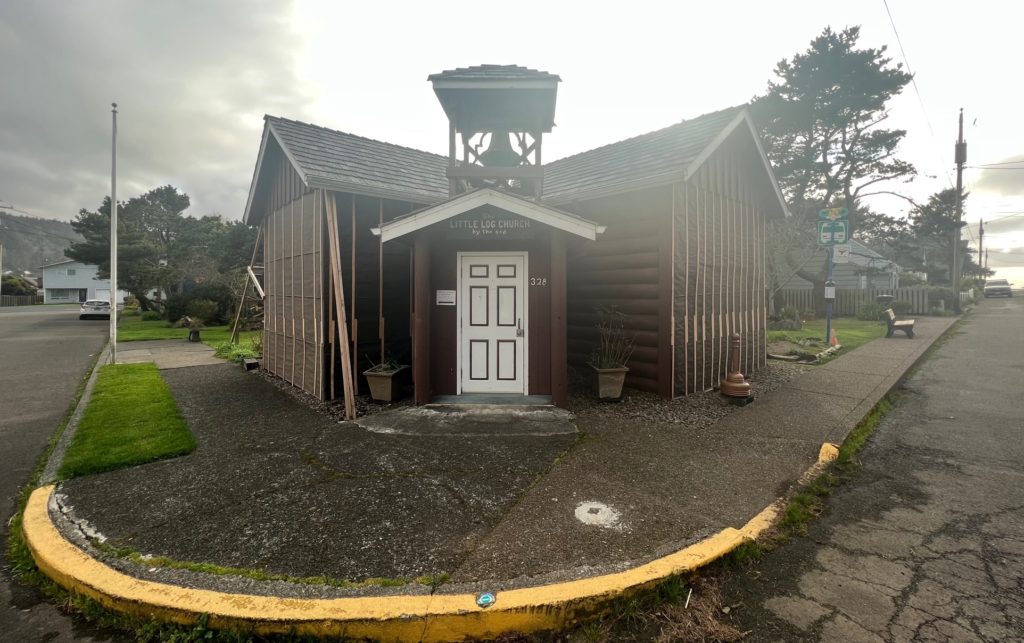
By QUINTON SMITH/YachatsNews.com
YACHATS – The Yachats City Council voted 3-2 Thursday to seek bids for a structural engineering report so it can get estimates for possible repairs to the city’s deteriorating Little Log Church Museum building.
It was the essentially same decision the council made two months ago – except this time Councilor Anthony Muirhead joined Mayor Leslie Vaaler in voting no after another confusing and contentious 90-minute discussion on the project.
An hour’s discussion during the council’s workshop portion of its meeting and then another 30 minutes during the decision-making portion of the meeting was hampered by several factors, including:
- Despite years of debate over the project, a recommendation to proceed from the Parks & Commons Commission and a vote in January to seek engineering plans, newly-hired city manager Heide Lambert started Wednesday’s discussion by suggesting that the whole process stop and the city develop new “big picture” ideas for the property. But Lambert, who has been manager for three weeks and has been dealing with staffing issues that forced the closure of city hall to the public, also said she had been unable to do much research on past discussions because of time constraints, the absence of meeting minutes and other records, and was uncertain about basics of a project that could cost $500,000 or more;
- The council was left to itself to debate a second time the merit of a project without the benefit of a report outlining the background, history, issues, procedures, finances, possible solutions, and no written advice from the city’s attorney who had been asked to weigh in;
- At least two councilors were still unsure – despite two presentations by engineer Larry Thornton of Yachats – on how the project would be done even if the city agreed to proceed;
- And councilors either did not know, understand or disagreed on what the engineering report would do and what it could lead to. Is it a commitment to rebuild the church and repair the museum buildings or a just document to help obtain an estimate of what it would cost?
After a contentious discussion during the decision-making portion of the meeting, councilors voted 3-2 to have Lambert seek structural engineering bids – expected to be about $12,000 — for the building. Then it would pick a firm to create that document. Contractors rely on such plans to estimate what a project might cost – and then present a contract to their client to consider.
As he has twice previously told the council, Thornton explained to YachatsNews later Thursday that asking a structural engineer to develop plans so that contractors can estimate costs does not commit the city to proceed with the main project.
“All they will have is a document from a contractor to decide whether to sign or not,” Thornton said.
But even after the engineering report is done, he said, it may be too late to rebuild the church this summer, as was hoped.
“Most good commercial contractors have already filled their summer schedules,” he said.
McClain Construction, a commercial contractor from Eugene, had been holding open a window of time to work on the Yachats project this summer as a favor to Thornton. It is now seeking other jobs for that time period, he said.
“Usually if a client is this uncertain, you walk away,” Thornton said.
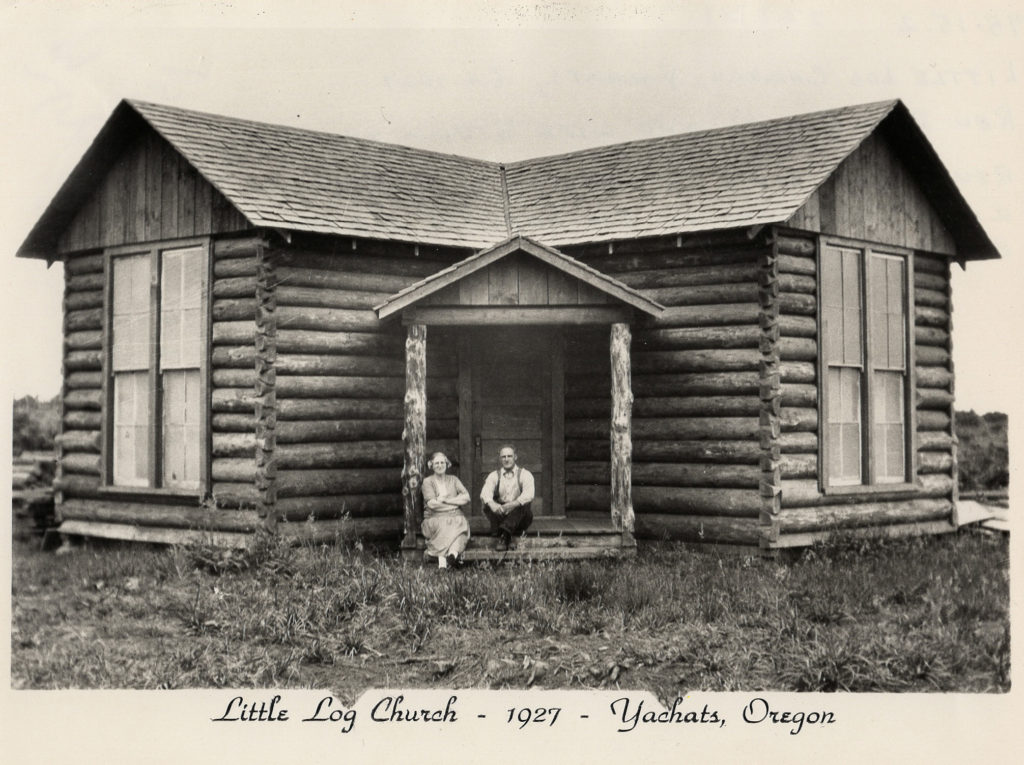
How we got here
The church has been deteriorating for years, but has accelerated in its decline. Many of the logs in the walls are rotten and allowed water to penetrate inside, there is dry rot in the walls, its wood foundation is crumbling, and some windows are failing.
The city already paid McClain to cover the church in tar paper to help protect it from the weather and to prop it up to prevent it from twisting.
The city acquired the church in 1986 and has done little with it since. Fully repairing the church has stalled for years as commissions and councils couldn’t decide whether to spend hundreds of thousands to save it. That began changing more recently when Thornton and the museum’s board warned the structure was in danger of falling down.
Thornton said the church would be repaired by replacing each wall and windows one at a time and installing a concrete foundation. Its roof is in good shape. The museum portion of the complex needs about $130,000 worth of work, but that can be done the year after the church repairs, Thornton believes.
The cost of the project is higher than normal residential or commercial jobs because under Oregon law the city must pay prevailing union wages, which typically doubles labor costs.
As far back as 2019 the city had budgeted money to repair or replace the church before deciding to stop. There is $200,000 in the 2021-22 budget to begin work. In its recommendation, the Parks & Commons Commission suggested the cost be split between the city’s 2021-22 and 2022-23 budgets.
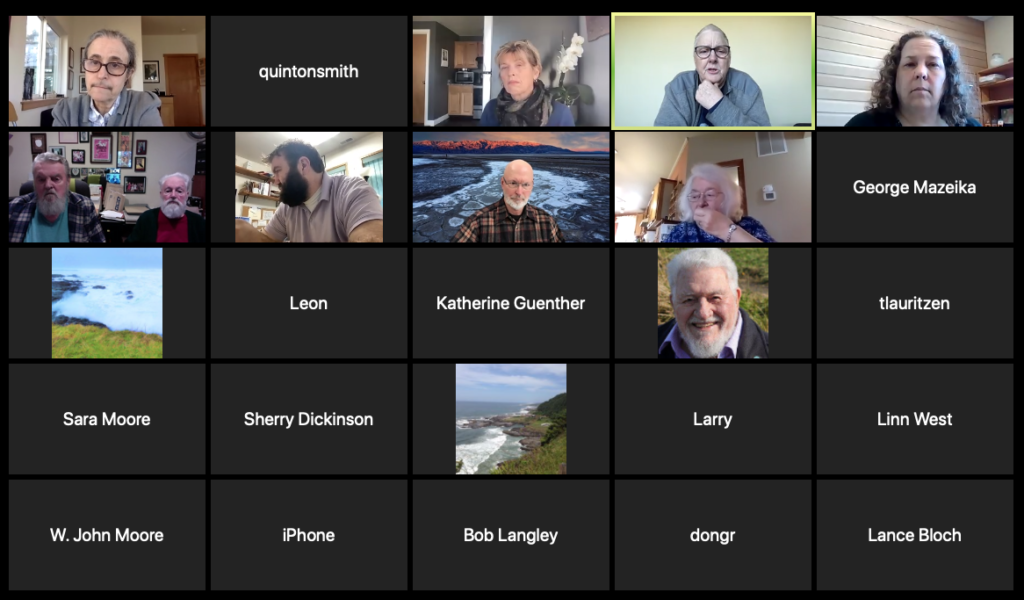
Councilor views
During one part of Wednesday’s discussion, Vaaler said she continues to have misgivings about repairing the church – she has voted against spending on the project since 2019 — and repeated her desire for a deeper community survey about attitudes toward it. Vaaler said she ran for mayor on transparency, public involvement and “responsible spending” and read from a voter’s pamphlet statement from her 2020 campaign for mayor – and said her large margin of victory meant people expected that of her. Vaaler said the city also needed to protect its reserve funds.
“We need to look at long-term, big picture projects,” she said.
On Wednesday, during just the second Finance Committee meeting in a year, committee members and Vaaler were told that the city is sitting on $8 million in reserves because it has sent little on projects or personnel the past two years.
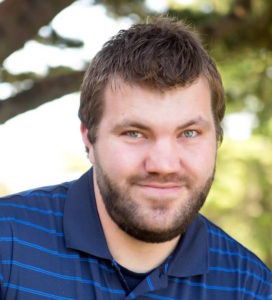
Muirhead explained his switch from a yes vote in January to a no vote Wednesday was “not because I’m opposed to the information but because we’re avoiding the bigger question” of committing to a project that will likely cost more than $500,000. Muirhead also said the city’s attorney advised against sending a letter to McClain Construction asking for an engineering study “unless you are willing to spend a half million dollars.”
“So here we are and it’s time to have that discussion,” he said.
Councilor Ann Stott argued that everything about the Little Log Church project has been transparent, there was community involvement during many Parks & Commons Commission meetings and again before the council, and that she disagreed with the city attorney’s advice and approach.
“I’m very frustrated,” she said. “We voted on this a couple of months ago. I’m frustrated that we take a vote and do not follow through on it. It just seems to be a pattern.”
Stott also said that it was unfair to thrust Lambert into the middle of a long-running, complicated and controversial project during her first weeks on the job and after “walking into a hornet’s nest at city hall.”
Councilor Greg Scott said he wanted to rely on the recommendations of the Parks & Commons Commission and others like Thornton.
“I want to trust others,” he said, while admitting he was struggling with the decision.
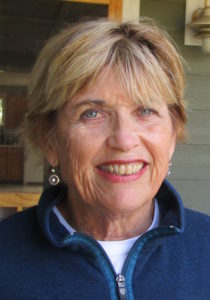
During the workshop discussion, Councilor Mary Ellen O’Shaughnessey talked first about what should be inside the museum, asked basic questions about the project and process, expressed concern about the project’s ultimate cost, but supported seeking the engineer’s plans. But at some point the council will have to make a decision, she said.
“If we’re the most unpopular council in history, maybe we have to make a decision,” O’Shaughnessey said.
When given the opportunity to speak, Parks & Commons Commission chair George Mazeika didn’t mince words – and his frustration.
“Either the council hasn’t listened or understood or just wants to micro-manage this project,” he said, pointing out that all of the concerns about the church project have been discussed and explained repeatedly at commission and council meetings.
“You’ve asked the commissions to do the work … but you don’t seem to take our recommendations,” Mazeika said. “Either you trust us and rely on us to give you accurate information or get rid of us and do everything yourselves.”
- Quinton Smith, a longtime Oregon journalist, is the founder and editor of YachatsNews.com and can be reached at YachatsNews@gmail.com



If the mayor wants more public discussion on the Little Log Church project, then so be it. The city council has definitely discussed the subject to death. It’s a simple matter. If the residents of Yachats want to start repairs on the church this summer, then the council has to get the lead out. If there’s no interest in the project, then drop it and move on to a project that actually does interest the residents of Yachats. After all, it’s their town. They live there. The Little Log Church means a lot to me because my brothers and I attended sunday school and church there when we were kids growing up. I’d hate to see it torn down, but my family doesn’t live there any more. The city council needs to take action now, not later. Don’t be a “do nothing” council. The residents of Yachats, I’m sure, expect action that fully reflects their desires and needs.
This project is a waste of money. Half a million dollars could be better spent on other crucial items our city actually needs, such as better cell phone coverage for our entire area. I get that this is a historical building, etc. It is also a church. Using city money to fix it sounds like supporting religious belief structures when there is a constitutional requirement that church and state remain separate.
Most folks forget that this is no longer a church. It is a museum and holds a lot of history from our area.
And it is a venue for many in the entertainment arena as well as personal uses.
I think the Little Log Church is more than a religious structure, if it can be called that at all. It represents our historic beginnings. And if you look around there isn’t much left of our history on display. For years the log church has filled this purpose. Do we really want this last bit of old Yachats to crumble?
There are 122 land use policies in Yachats’ comprehensive land use plan. The plan describes those policies has having the force of law, and obligates the Land Use Authority (City Council) to abide by them.
Protecting and maintaining the Little Log Church is a land use decision that has already been made by a prior City Council, and codified as land use policy in the city’s comprehensive land use plan (Goal A Policy #9). It is an objective fact that the Little Log Church hasn’t been protected, so I’m sort of confused about the nature of our land use policies, how they are implemented, and how they factor into ongoing land use decisions – including Title 9 code enforcement.
If we have a policy, with the force of law, protecting the Little Log Church, then how did it wind up in the state that it is in? What is the root cause of this failure, because it clearly wasn’t lack of policy.
And the stated the need for more public involvement before making a decision about saving the building, or walking away, seems somewhat disingenuous. Goal K, Policy 1 of the comprehensive land use plan obligates the city to develop a public participation plan and to publish it so everyone will know how public influence will be incorporated into our land use planning activities. Goal K actually says:
“The City shall continue to use the adopted public involvement plan.” Yet, in reality, there is no public involvement plan.
So while the Little Log Church rots, in violation of our land use policies, we’ll wait for public involvement in accordance with a plan that doesn’t exist – also in violation of our land use policies.
It’s a significant chunk of money and I don’t think the value is there for most Yachatians. Just tear it down and seek public comment on uses for the property. It would make a nice park/picnic area/botanical garden and there’s a nice Gunnera there already. And no, the city government shouldn’t be supporting what is essentially a religious structure.
It has been a museum for many years and that includes the whole structure.
Seems history, like civility and common purpose are relics of the past.
There aren’t many gems left in the ‘gem of the Oregon Coast’; as Mr. Conner aptly states, protecting the little log church is our responsibility, so do it.
As an aside, the use of a building is not a factor in determining its historic significance. This is not an issue of separation of church and state.